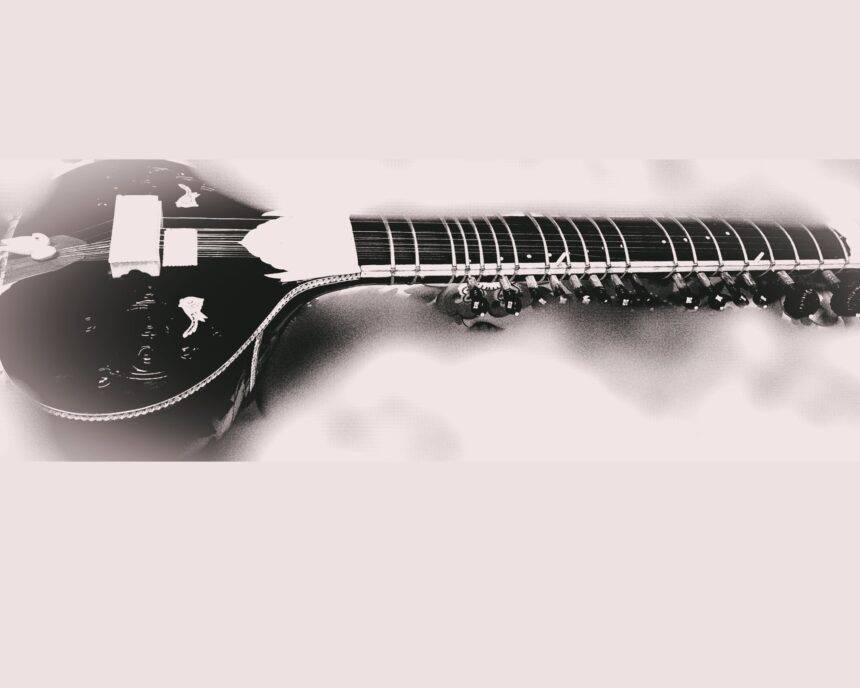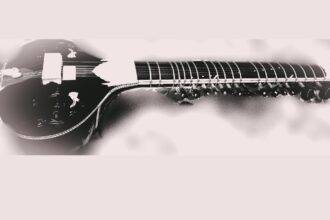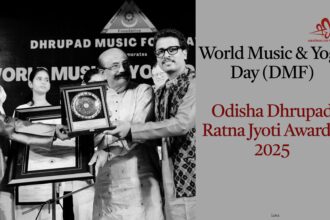As was previously said, the term “alap” is an umbrella term that encompasses various aspects that add to its complexity. This is especially clear in instrumental music, where instruments like the sitar, which primarily depend on the alap to provide the basic structure for their performances. Each alap phase is an essential and complex component of the musical experience, showcasing the instrumentalist’s technical mastery in addition to their aesthetic appeal. The alap unfolds in a structured sequence comprising the alap, jod, and jhala. The alap serves as the initial step, functioning as an exposition of the raga. In this phase, the instrumentalist meticulously establishes the essence of the raga, skillfully painting its image in a slow tempo, free from rhythmic constraints. This deliberate exploration sets the foundation for a profound musical journey, paving the way for the subsequent phases of jod and jhala. The alap
As the alap gradually unfolds its melodic phases, it seamlessly transitions into the enchanting stage of jod, marking a pivotal juncture in instrumental music. This phase, arguably the most enthralling and intricate, introduces a paradoxical dance of rhythm. While ostensibly devoid of any explicit beat, the jod unfurls a mesmerizing complexity of rhythm that defies conventional expectations. The sheer fascination lies in experiencing and sensing the existence of rhythm within a seemingly rhythm-free space. It’s a testament to the musicians’ prowess that they can infuse such intricate rhythmic patterns without the aid of a discernible beat. Each step of improvisation and elaboration within the jod adds layers of surprise, creating a dynamic interplay of musical elements. The performers navigate through this rhythmic labyrinth with a delicate balance, showcasing not only technical virtuosity but also a profound understanding of the rhythmic nuances inherent in this phase of the alap. The audience is left in awe, captivated by the mastery displayed in maintaining and unraveling the complexity woven into the very fabric of the jod.The allure of the jod phase is heightened by the incorporation of exclusive ornamentations and instrumental elements. The meticulous use of ornamentations becomes a language of its own, allowing musicians to convey emotions and nuances with unparalleled precision. Right-hand bol patterns add a rhythmic complexity, while taans, with their swift melodic runs, elevate the musical narrative. Ekhada taans bring a sense of singularity and emphasis, creating moments of sonic brilliance. The inclusion of ulta jhala and thok jhala introduces a dynamic texture, adding layers of intensity and flair to the overall musical tapestry.These elements not only inject excitement into the performance but also contribute to the distinctiveness that makes the jod so special for instrumentalists.
Within the rhythm-free expanse of the jod phase, performers discover an unrestricted canvas for artistic improvisation. Here, the absence of rhythmic constraints provides a liberating environment, allowing musicians to explore and express their individuality with ample freedom. This is the space where creativity blossoms and each performer can infuse their unique style into the performance. In this boundless realm, musicians embark on a journey of spontaneous creation, weaving intricate patterns and melodic nuances with their own confined beat. The jod becomes a place for artistic expression, where performers can showcase their virtuosity and distinctive musical identity. The audience witnesses not only the technical prowess of the musicians but also the richness of their creative spirit, making each rendition of the jod a unique and memorable experience.
Following the intricate exploration of jod, the alap reaches its culmination with the dynamic and exhilarating jhala. Representing the final stage of this musical journey, the jhala is characterized by rapid and pulsating movements. This phase introduces a burst of energy, marking a departure from the contemplative pace of the preceding segments. In jhala, the tempo accelerates, and the instrumentalist engages in a virtuosic display of fast-paced movements. The term “jhala” itself signifies a shimmering or cascading effect, and indeed, this segment is characterized by a continuous and rhythmic repetition of notes. The rapid strumming or plucking of strings, coupled with intricate fingering techniques, creates a sonic tapestry that is both exhilarating and mesmerizing.
The jhala serves as a showcase of the instrumentalist’s technical prowess, requiring precision, speed, and control. It adds a vibrant and festive element to the overall performance, leaving a lasting impression on the audience. The fast-paced nature of the jhala not only creates a sense of climax but also provides a thrilling conclusion to the alap, leaving the listeners in awe of the skill and dexterity demonstrated by the performer.
The alap, in its expansive essence, transcends the conventional boundaries of its definition within instrumental music. It serves as a comprehensive section that encapsulates nearly every facet of sitar music. Beyond being a mere prelude, the alap emerges as a rich tapestry, weaving together various elements that define the intricacies of sitar performance. Through skilled and nuanced renditions, the instrumentalist delves into the depths of melodic exploration, rhythmic intricacies, and ornate embellishments. The alap becomes a canvas for artistic expression, allowing the musician to showcase their virtuosity and interpretative prowess. It is not merely a standalone introduction but a profound musical journey in itself. Having traversed the diverse landscapes of alap, the performance naturally progresses towards the subsequent phases of instrumental expression. The foundation laid during the alap resonates throughout the performance, shaping the musical narrative and setting the stage for the unfolding chapters of the instrumental journey.
Beyond the conventional structural phases, there exists a nuanced perspective on the alap—one that delves into the technical intricacies through the concept of “Angas.” Sri Bimalakanta Roychoudhury’s exploration of these Angas, documented in his Dictionary of Hindustani Classical Music, sheds light on a less common but historically significant dimension of alap. Traditionally, the alap was approached with a meticulous adherence to these 13 Angas, offering a comprehensive framework for musicians. While not as prevalent in contemporary practice, some artists proudly claim to follow this traditional system, adding a layer of authenticity to their renditions. Each Anga in the alap serves as a technical facet, contributing to the overall aesthetic and structural integrity of the performance. Exploring the alap through the lens of Angas provides a unique and detailed roadmap for the musician, guiding them through a series of carefully crafted technical elements.







